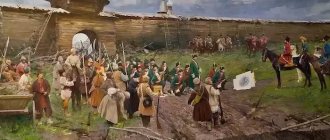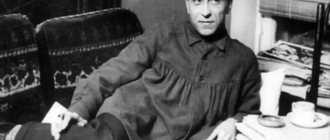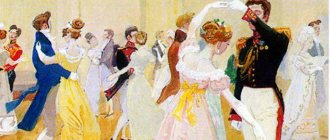4.4
Average rating: 4.4
Total ratings received: 366.
4.4
Average rating: 4.4
Total ratings received: 366.
Oleg's reign lasted 33 years, from 879 to 912. This prince ascended the throne as regent under the young prince Igor. He is traditionally attributed to the Rurik dynasty, but it is not a fact that Oleg was a relative of Rurik. His reign was successful in terms of foreign policy; less is known about domestic policy.
Prince's personality
In the 18th century, historian Vasily Tatishchev suggested that Oleg was Rurik’s brother-in-law, that is, he was the brother of his wife Efanda. He took such information from the Joachim Chronicle. In general, all chronicles give only a brief description of the prince.
Rice. 1. Oleg the Prophet.
From medieval sources, nothing is known about Oleg’s wife and children. This is strange, considering that he ruled for 33 years and was a pagan, because they practiced polygamy in the 9th-10th centuries.
A number of historians are inclined to believe that the prince’s name has Slavic or Turkic roots. They use ancient Bulgarian inscriptions from the early 10th century as evidence.
Rice. 2. Prince Oleg.
Oleg's board
In 882, the prince gathered an army of Slavs, Varangians and Finno-Ugrians (Chud, Merya and Ves tribes) and set off on a campaign from Novgorod the Great to the south. He occupied the cities on the Dnieper - Smolensk, Lyubech and Kyiv. From the latter he expelled the Varangians Askold and Dir and made the city the capital of his state. These two princes had previously, in 864, left Novgorod to the south and began to rule in Kyiv.
In 883-885 Oleg established control over three East Slavic tribes:
- Drevlyans . They lived on the territory of modern Zhytomyr region.
- Northerners occupied the territory of the Chernigov and Sumy regions.
- Radimichi . They lived in the Gomel region.
According to the chronicles, Oleg had to fight with the Khazars and with the East Slavic tribes who lived between the Dnieper and the Danube, the Tivertsy and the Ulichs. In 898, the Hungarians passed near Kyiv; at the end of the 9th century they moved from Eastern Europe to the plain between the Carpathians and the Danube.
Oleg's reign ended with a major success - a peace treaty with Byzantium. It was concluded after the war of 907-911. As a result, Russian merchants received the right to live in Constantinople, and warriors began to be hired to serve the emperor.
There are few historical sources about Prince Oleg, less than about his contemporary in Western Europe or Byzantium. Two versions of his biography are contained in the “Tale of Bygone Years” and in the Novgorod Chronicle.
Rice. 3. Rus' under Prince Oleg.
Prophetic Oleg is the creator and guardian of the Russian state. To the 1130th anniversary of the unification of the north and south of Rus'.
How the prophetic Oleg is now planning to take revenge on the foolish Khazars,
For the violent raid he doomed their villages and fields to swords and fires; With his retinue, in Constantinople armor, the Prince rides across the field on a faithful horse. A. S. Pushkin. "Song of the Prophetic Oleg."
Prophetic Oleg is perhaps one of the most mysterious rulers of Rus'. Sage on the throne, prince-magician, priest of Perun. He successfully continued the work started by Rurik-Falcon. Oleg united the Slavic lands in the face of an external threat - the Khazar Khaganate, the growing power of the West and the machinations of the Byzantine Empire.
According to the story “The Tale of Bygone Years”, after the death of Prince Rurik in 879, Oleg took the throne, since Rurik’s son Igor was still small. Before his death, the Grand Duke chose Oleg as his successor (according to one version, his brother-in-law, according to another, a relative) and ordered him to rule the Russian lands until the legitimate ruler grew up. Having headed Northern Rus', Prince Oleg did not sit idly by and immediately continued the work of his predecessor - the unification of the Slavic Russian lands into a single power. Less than three years had passed since the death of Rurik, when he gathered a powerful army - according to the chronicle story, it included warriors from the Varangians, Slovenes, Krivichi, Chud, Meri, Vesi and, taking little Igor with him, he moved south. He subjugated Smolensk and Lyubech (Northern Key to Kyiv) to his power, placing his governors there. The cities were taken without a fight.
After this, his army on boats moved down the Dnieper to Kyiv. Askold and Dir ruled in Kyiv at this time. There is no exact information about their origin. The Tale of Bygone Years reports that these were two Varangian boyars, but not of the Rurik tribe and not of the princely family. At one time, they asked Rurik for leave to go to Constantinople (Constantinople), on the way they captured Kyiv and began to rule there. Some researchers have put forward a hypothesis that these were representatives of the local princely dynasty, descendants of the founder of Kyiv - the legendary Prince Kiya.
It was not for nothing that Oleg was called the Prophetic. He decided not to resort to unnecessary bloodshed, because Askold and Dir were not going to give up power in Kyiv just like that. Oleg resorted to military stratagem. Leaving behind most of his forces, the prince approached the city on several boats and sent a messenger to the Kiev rulers to report that visiting merchants had arrived, coming to the Greeks from Novgorod: “Come to us, to your relatives.” Askold and Dir, unaware of the trap, came to the banks of the Dnieper. But instead of the merchants, Prince Oleg came out to meet them with little prince Igor in his arms: “You are not princes and not of a princely family, but I am of a princely family,” he said and pointed at Igor. “And this is Rurik’s son!” Askold and Dir were not spared. But they buried him honorably on the mountain.
Thus, 1130 years ago, in 882, the north and south of Rus', the two main centers of the Russian land - Kyiv and Novgorod - were united into a single state. This sharply increased the power of the Russian state. Oleg decided that Kyiv would be more convenient for governing the Russian land and declared it the capital. “May this be the mother of Russian cities!” - chroniclers convey the words of the Grand Duke. This is how a state was formed, which was included in history textbooks as the Old Russian State, or Kievan Rus. The names are conditional, because the inhabitants of the state themselves called it the Russian land, Russia.
Oleg almost immediately began to prepare for further campaigns. The army was prepared for a new campaign. Already in the next 883, Oleg began an armed conflict with the Drevlyans (a union of tribes living in Ukrainian Polesie). The Drevlyans were conquered and subjected to tribute - they took a black marten from each house. In 884, Oleg began a war with the northerners and subjugated them to Kyiv. The northerners inhabited the territories of modern Chernigov, Sumy, Bryansk, Kursk, and Belgorod regions and paid tribute to Khazaria. In 885, Oleg sent envoys to the Radimichi, saying: “Who should we give tribute to?” They say: “Kozarom”. And Oleg said to them: “Don’t give it to the goat, but give it to me.” And Dasha Olgovi is a shloyag, just like a kozar is a dayahu.” The Union of Radimichi lived in the area between the upper Dnieper and Desna rivers along the Sozh River and its tributaries. Thus, two alliances of tribes - the northerners and the Radimichi - were freed from the power of the Khazars. The unions of the Ulichs and Tiverts, who lived from the lower reaches of the Dnieper, the Southern Bug and the Black Sea coast, in the area between the Dniester and Prut rivers, as well as near the Danube, offered more stubborn resistance to Oleg and were later incorporated into a single power.
There is evidence, as reported by the Hungarian chronicle, that Oleg was forced to fight with the Hungarians during their resettlement to Europe. According to the Hungarian chronicle, the Hungarians defeated the Polovtsians and besieged Kyiv. Whether Oleg was there at that time is unknown. The townspeople had to give a ransom of 10 thousand marks in silver and 1 thousand horses. In addition, some of the Rus took part in the campaign to the west. Russian sources mention that the Hungarians simply passed by in 898. It should be noted that later the Hungarians were allies of the great princes of Kyiv, participating together in wars with Byzantium.
Grand Duke Oleg lived in the capital city of Kyiv for 25 years, expanding the borders of the Russian state, conquering and annexing neighboring tribes and nationalities to his state. During this time, Prince Igor matured and became co-ruler of the Grand Duke, studying the science of management, as reported in the chronicle, “accompanied Oleg and listened to him.” Oleg personally selected a bride for his nephew - Olga, originally from Pskov. By 907, Oleg conceived a grand campaign to attack the Byzantine Empire. A large fleet was assembled - 2 thousand boats, each could transport 40-50 warriors. Approximately 80-100 thousand troops, which included squads of the Varangians, Novgorod Slovenes, Krivichi, Drevlyans, Radimichi, Polyans, Northerners, Vyatichi, Croats, Dulebov, Chud, Meri, went on a campaign. The Byzantine Romans called the Rus - “Great Scythia”. The army marched by sea and land, on horseback. Kyiv was left to Igor.
The Byzantine Emperor Leo VI the Wise (or Philosopher), seeing the powerful army of the Rus, did not dare to give battle and locked himself in the city, giving the surroundings of Constantinople to be plundered. To prevent the Russian fleet from entering the harbor, it was closed with chains. Oleg's army destroyed the surrounding area, but did not stop there. Oleg wanted to conquer Constantinople. The Grand Duke was excellent at science - “surprised - won.” He amazed the townspeople by ordering the boats to be put on wheels, and, catching the wind, the ships moved to Constantinople. The onslaught of the Rus caused horror among the Romans. The Byzantine emperor-basileus sent envoys to Oleg. They told him: “Do not destroy the city, we will give you the tribute you want.” Numerous foods and wine were brought to the Russian soldiers. But the Prophetic Oleg, sensing something was wrong, forbade them to touch food and drink. And for good reason. Food and drinks were poisoned. The enemy, unable to win fairly, conceived a meanness. The Romans were frightened, saying: “This is not Oleg, but Saint Dmitry, sent to us by God.” And they offered peace on Russian terms.
Oleg, like a real leader, first of all took care of the soldiers and ordered the Romans to give each soldier 12 hryvnia of silver. Hryvnia is a monetary and weight unit of ancient Rus', equal to approximately 200 grams. The amount was huge, considering the size of Oleg’s army. The Byzantine Empire pledged to pay tribute to Rus'. Russian visiting merchants received the right to duty-free trade, the Byzantines were obliged to supply them with food and let them into the baths for free. In addition, the Byzantines had to supply the Russians returning home with food and naval equipment. As a sign of his patronage over Constantinople, the prince-magician nailed his shield to the gates of the city.
In 911, Grand Duke Oleg sent an embassy to the Byzantine capital, which confirmed the terms of peace and concluded a new treaty. Compared to the 907 agreement, the clause on duty-free trade disappears from it.
There is no exact information about Oleg’s death. According to the chronicle, in 912 Oleg died “from his horse” - he was bitten by a snake, he fell ill and died. He was buried on Mount Shchekovitsa. The Novgorod Chronicle also talks about a snake bite, but places his grave in Staraya Ladoga (mound of the Prophetic Oleg), and also reports that Oleg went “overseas.” Another difference between Novgorod sources is that they report Oleg’s death in 922. Oleg went to the north of Rus', giving the reins of power in Kyiv to Igor.
Therefore, a number of researchers believe that Oleg could have died in a battle with the Khazars. Sometime after 912, according to the Arabic author Al-Masudi, a Russian fleet of 500 boats entered the Kerch Strait. The Khazar Kagan gave permission to the Russian flotilla to pass through the Don to the Volga, where they were going to strike the lands subject to Persia. The Khazar ruler demanded half of the spoils for himself. The Rus' campaign was very successful; they returned with rich booty. The Khazar Khagan received his share, but the Khazars violated the agreement. While the Rus were devastating the coast of the Caspian Sea, a large army was assembled, and the route along the Volga was blocked. The bloody battle lasted for three days, most of the 20-30 thousand Russian troops died in an unequal battle. A small part was able to break through higher up the river, but was destroyed by the allies of the Khazars - the Burtases and the Volga Bulgars. The snake of the chronicle messages symbolizes betrayal, and Oleg could well have fallen in this battle.






